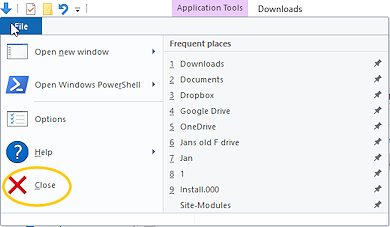
Note: This site will be taken down July 1, 2024.
Jan's Working with Windows 10:
Folders: Move, Delete, Rename
You will change your mind… about where you put a folder… about what you named it… about having the folder at all. In this section you will learn how handle these changes.
Windows offers so many ways to do things that it can sometimes be confusing. Not to worry! As long as you learn at least one way, you can manage. Some folks never want to use the mouse if they can use the keyboard, and others are just the opposite. That's the beauty of modern computing - Different strokes for different folks.
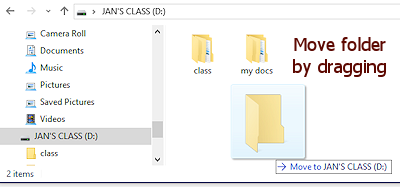
Methods to move or copy files and folders:
 Left click to drag and drop
Left click to drag and drop
 Right click to drag and drop
(Shows a menu of choices)
Right click to drag and drop
(Shows a menu of choices)- Ribbon button: Move to or Copy to
- Cut or Copy and then Paste using:
 Context menu
Context menu  Key combos
Key combos- Ribbon buttons
The methods you will be using work for both files and folders. Similar methods work to copy instead of move the files and folders.
| |
Step-by-Step: Move Folders |
|
| What you will learn: | to move a folder between windows by dragging to move a folder between windows by right-dragging to undo and redo a move with context menu to move a folder using Cut and Paste with key combo between windows to refresh the File Explorer view to delete a folder to rename a folder to undo a rename |
Start with: ![]() , two windows
from the previous lesson - one showing what is on your removable
Class disk and one showing the contents of the folder my docs on the Class disk. Both windows show Medium Icons.
, two windows
from the previous lesson - one showing what is on your removable
Class disk and one showing the contents of the folder my docs on the Class disk. Both windows show Medium Icons.
Move: Drag
Drag and drop - Mouse: With the pointer over what you want to move, press down the left mouse button and hold it down while moving the mouse. The object is dragged along with the pointer. When you release the left mouse button, the object is dropped at the spot where the tip of the pointer is.
Drag and drop - Touch: (for some devices) Do a long press on the the object until it shows as selected. Drag your finger. Lift up your finger to drop the object to the new location. This action does not work for all devices or all programs.
-
 Drag the title bar of each of the two windows (the
contents of the removable drive and of the folder my docs) so that the windows do not overlap.
Resize the windows (from lesson Control Window), if you need to, so that they fit side-by-side or one above the other on your monitor.
Drag the title bar of each of the two windows (the
contents of the removable drive and of the folder my docs) so that the windows do not overlap.
Resize the windows (from lesson Control Window), if you need to, so that they fit side-by-side or one above the other on your monitor.
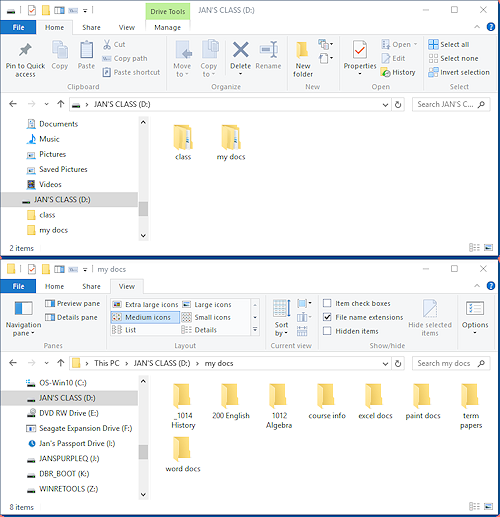
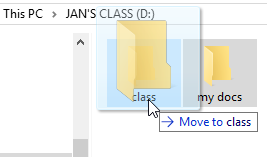
 Drag the folder excel docs from the my docs window until your pointer is over folder class in the drive window.
Drag the folder excel docs from the my docs window until your pointer is over folder class in the drive window.
The icon for this folder class is highlighted once it is selected.Screen Tip: A screen tip tells you whether you are about to Move or to Copy the folder. Excellent feature! Remember to pay attention to that!
Tablet: With no keyboard attached, a tablet may give you a menu of options: Copy, Move, Create a shortcut, or Cancel. This is the same menu that otherwise shows with a right drag. Choose Move.
- Drop the folder excel doc on top of the folder class by releasing the mouse button that you were holding down.
The folder location is changed to where the pointer was, or, in this case, to the object that was highlighted. The original window refreshes to line up the icons again. To see for yourself, you can open the class folder by double-clicking it. Progress Dialog: When the total size is large enough, a dialog displays while the computer moves, copies, or deletes folders and files.
A progress bar gradually fills in to show you how much of the job has been
done. (The job in this lesson will finish before such a dialog can display!) There is a Pause button || and a Cancel button X... if you are fast enough!
Progress Dialog: When the total size is large enough, a dialog displays while the computer moves, copies, or deletes folders and files.
A progress bar gradually fills in to show you how much of the job has been
done. (The job in this lesson will finish before such a dialog can display!) There is a Pause button || and a Cancel button X... if you are fast enough! 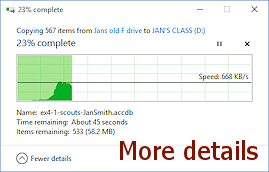 Clicking 'More details' expands the message box to show a chart of transfer speed, an estimate of the time left, the number of items left, and the total size of what is left to move, copy, or delete. Be sure to check this view when you think nothing is happening with a move, copy, or deletion!
Clicking 'More details' expands the message box to show a chart of transfer speed, an estimate of the time left, the number of items left, and the total size of what is left to move, copy, or delete. Be sure to check this view when you think nothing is happening with a move, copy, or deletion!The 'Time remaining' will recalculate and change a LOT during the process, especially if there are some large files or a lot of small ones.
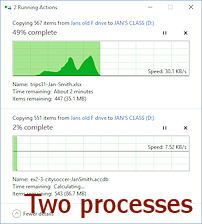 You can run multiple actions at once and see the progress of each one separately, but in the same window.
You can run multiple actions at once and see the progress of each one separately, but in the same window.
![]() Moving or Copying? It is easy to move when you meant to copy. Read the dialog box carefully. It tells you what action is happening, Moving, Copying, Deleting, Recycling. Always check on what you just
did!
Moving or Copying? It is easy to move when you meant to copy. Read the dialog box carefully. It tells you what action is happening, Moving, Copying, Deleting, Recycling. Always check on what you just
did!
![]() When does dragging move
and when does it
copy?
When does dragging move
and when does it
copy?
When the original location and the destination
location are on the same drive, the folder is moved when you drag. If
the destination location is on a different drive, the folder is copied.
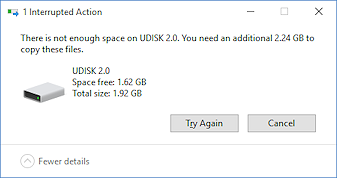
![]() Problem: Not
enough space
Problem: Not
enough space
If there is not enough free space on the destination drive to hold what you are copying or
moving, you will get a message that tells you how much more space you need. Very helpful!
Solution 1: Free up space
Leave the message open while you delete or move
files/folders on the destination disk to make more space. Then click the Retry or Try Again button.
With this method you don't have to select again!
Solution 2: Pick new location
Choose Cancel and find a different location for your copy/move.
Solution 3: Reduce amount to move/copy
Choose Cancel and select a smaller set of files and then try
again.
Why is it hard to know if there is enough
space ahead of time?
Files can take more space on one drive than they do
on another. That happens when the drives are formatted with different rules,
which is common when there are two different types of storage, such as a hard
disk and a USB drive.
Move: Right Drag
Right Drag with Mouse: Hold down the right mouse button
and drag the mouse.
Right Drag with Touch: Some touchpads have a right click button or let you press down on the bottom right section of the pad for a right click. Just press and hold briefly and then drag. On a touchscreen, touch and hold briefly. You should see an extra border or a circle around the touch point. Then you can drag.
If the directions above do not work with your device, check your device instructions.
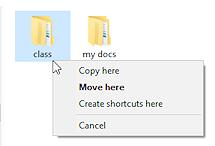
 Right drag the folder word docs to the folder class .
Right drag the folder word docs to the folder class .
When you drop the folder, a context menu appears.- Choose .
Notice all the choices: Copy Here, Move Here, Create shortcuts here (to the object(s) that you right dragged), or Cancel. The one in bold is what will happen if you don't choose something from the menu.
 Recommended: Right drag files and folders whenever possible and you won't have to remember whether the object will be copied or moved. The menu will always give you a choice! Next best method is Copy and Paste or Cut and Paste (See below).
Recommended: Right drag files and folders whenever possible and you won't have to remember whether the object will be copied or moved. The menu will always give you a choice! Next best method is Copy and Paste or Cut and Paste (See below).
Undo and Redo Move
Windows keeps track of your actions. Often you can reverse those actions with the Undo command. If you find that you were right the first time, the Redo command will do what you just undid. But you have to be quick. The commands are not available forever.
 Right click in a blank area of the window and from the context
menu, select .
Right click in a blank area of the window and from the context
menu, select .
(The menu item changes to show the last action that you took.)Nothing sees to change in this window. The folder word docs disappears. It is now in the class folder.
-
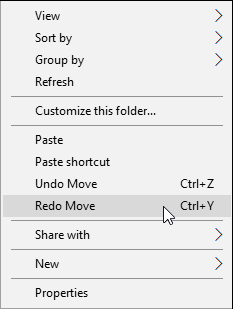 Repeat to get the menu back again.
Repeat to get the menu back again.
A new command shows, Redo Move, that will reverse what you just did (moved the word docs folder).The Undo Move command is still in the menu but it is for the previous move of the folder excel docs. It can be hard to know what an Undo or Redo command will do.
 Problem: No Undo Move in the menu
Problem: No Undo Move in the menu
You did something else besides what is in the directions. It does not take much to erase the Undo list!
Solution: Ignore the next three steps. With the history list changed, you would have to manually move the folders back and forth yourself. That's not worth the effort at this point.
-
 Click on .
Click on .
The excel docs folder appears back in the original window. -
Show the menu again and select .
The excel docs folder go back the the class folder. - Redo again.
The word docs folder returns to the class folder. Hurrah!  Practice the Undo and Redo actions using the key combos, CTRL + Z to undo and CTRL + Y to redo.
Practice the Undo and Redo actions using the key combos, CTRL + Z to undo and CTRL + Y to redo.
When you are finished practicing, the class folder should contain the folders excel docs and word docs again.
It would be nice to see a list of the actions that are available to Undo and Redo, but there is not one for this type of window.
Move: Cut and Paste
When you cut files and folders in File Explorer, whatever you cut is not actually removed until after you paste. If you never paste, nothing is changed. This is different from editing documents where cutting removes the selection from the document even if you never paste anywhere.
There are several ways to Cut and Paste (or Copy and Paste) - key combo, ribbon, right click menu.
- In the my docs folder,
 click on the folder 200 English to select it.
click on the folder 200 English to select it. 
 Use the key combo CTRL + X (hold down the CTRL key and press and release the X key).
Use the key combo CTRL + X (hold down the CTRL key and press and release the X key).
The selected folder does not disappear. The icon is faded but the text is still dark. Click the icon for the class folder in the other File Explorer window to select it.
Click the icon for the class folder in the other File Explorer window to select it.
 Use the key combo CTRL + V to paste what you cut.
Use the key combo CTRL + V to paste what you cut.
Whoops! The folder 200 English is not in the class folder but instead is beside the class and my docs folders. Looks like you must open the folder that you want to paste into. Undo: Use the key combo CTRL + Z to undo your paste.
Undo: Use the key combo CTRL + Z to undo your paste.  Cut the folder 200 English again. (CTRL + X)
Cut the folder 200 English again. (CTRL + X)
 Double click the folder class and
Double click the folder class and  click in a blank area of the Contents pane.
click in a blank area of the Contents pane.-
 Paste. (CTRL + V)
Paste. (CTRL + V)
The folder 200 English vanishes from its original home and appears in the class folder. 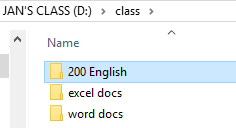
 Refresh: Press the F5 key or the Refresh button
Refresh: Press the F5 key or the Refresh button  at the right end of the Address bar to refresh the listing of folders.
at the right end of the Address bar to refresh the listing of folders.
They should be in correct alphabetical order now.
Delete Folder
![]() Recycle Bin and a USB drive: If your computer 'sees' the USB drive as
a removable drive as it should, then it will not save deletions to the Recycle Bin. But if it sees the drive as an additional hard drive or SSD drive, then it will be happy to use the Recycle Bin.
Recycle Bin and a USB drive: If your computer 'sees' the USB drive as
a removable drive as it should, then it will not save deletions to the Recycle Bin. But if it sees the drive as an additional hard drive or SSD drive, then it will be happy to use the Recycle Bin.
Objects sent to the Recycle Bin can be undeleted later (if you don't wait too long).
 Click on the folder paint docs in the window for my docs to select it.
Click on the folder paint docs in the window for my docs to select it.
 Press the DELETE key on your keyboard.
Press the DELETE key on your keyboard.
Do you see a confirmation dialog?-
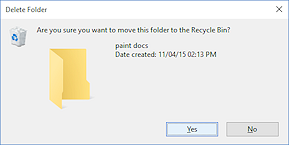 Move to Recycle Bin: Shows Recycle Bin icon
Move to Recycle Bin: Shows Recycle Bin icon
- What you are deleting is on a drive that the computer considers non-removable.
- The Recycle Bin properties are set to show a confirmation dialog. Otherwise the selection is deleted and sent to the Recycle Bin without notice.
-
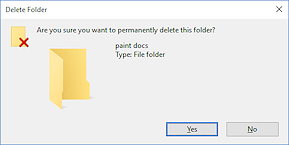 Permanently delete: Shows folder with red X
Permanently delete: Shows folder with red X
- You are deleting from removable media.
- What you tried to delete is too large to fit in the space allowed for the Recycle Bin.
 You cannot use Undo to get
back anything that was permanently deleted!!!
You cannot use Undo to get
back anything that was permanently deleted!!!
-
-
 Click on the Yes button.
Click on the Yes button.
Your folder is deleted. Which type of deletion - to Recycle Bin or permanent? - Use the key combo CTRL + Z to attempt to recover what you deleted.
If you saw a message about a permanent deletion, this won't work! That is normal for a removable drive. - If necessary, recreate the folder paint docs.
 Recover a
deleted object from the Recycle Bin:
Recover a
deleted object from the Recycle Bin:
When it is too late to use Undo, you may be able to recover deleted items from the Recycle Bin, if you act soon enough.
Open the Recycle Bin by double-clicking its Desktop icon.
A File Explorer window opens to show the contents of the Recycle Bin. You may have a delay if there are many files.The ribbon gets a new tab, Recycle Bin Tools: Manage.
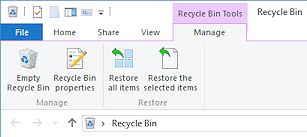 Select the item(s) you want to restore.
Select the item(s) you want to restore.- Use one of the following methods to restore:
- Ribbon button: Restore selected item(s).
The Recycle Bin will only hold so much and will clean itself out as it needs space for new deletions. So you can't undo your deletions forever. If you are deleting a large number of files or very large files, the Recycle Bin may not have room for all of them. So some will be permanently deleted immediately.
 To permanently
delete files or folders immediately:
To permanently
delete files or folders immediately:
Hold the SHIFT key down while pressing the DELETE key. The selected item(s) will NOT be put in the Recycle Bin even if they could have fit in it. They are destroyed. Fancy, expensive file recovery software may be able to get them back. Maybe! Check confirmation box for type of deletion: If the icon is the Recycle Bin, then you can undelete your deletion, at least in the near future. Otherwise it is a permanent loss.
Check confirmation box for type of deletion: If the icon is the Recycle Bin, then you can undelete your deletion, at least in the near future. Otherwise it is a permanent loss.
Rename Folder
If you can click or touch carefully, you can rename files and folders directly in File Explorer.
-

 Click on the icon for the folder paint docs to select it.
Click on the icon for the folder paint docs to select it.
-
Pause briefly and
 click again on the label area.
click again on the label area.
The name of the folder is highlighted, ready for your typing. Problem: The folder opened.
Problem: The folder opened.
You clicked too quickly, creating a double-click.
Solution: If a new window opened, close the new window and try again. If the display changed in the same window, click the Back button and try again. Problem: Lost
highlight for the label
Problem: Lost
highlight for the label
You clicked somewhere else, moving the focus off of the label.
Solution: Click the label again. -
 Type pictures and
don't click anywhere else yet.
Type pictures and
don't click anywhere else yet.
You changed your mind and don't want to rename after all! -
 While the name is still highlighted, press the ESC key at the upper left of your
keyboard.
The folder name will return to the previous name.
While the name is still highlighted, press the ESC key at the upper left of your
keyboard.
The folder name will return to the previous name.
 ESC key: Can often get you out of trouble when you are still in the middle of an action.
ESC key: Can often get you out of trouble when you are still in the middle of an action.Let's try a different name. The folder icon should still be highlighted.
 Click on the label.
Click on the label.
The folder name is highlighted again.
 Type reports , and then
Type reports , and then  click in a blank spot in the window.
click in a blank spot in the window.
The name is changed.
Hmmm. You still don't like this name.- Press the ESC key.
Nothing changes. This time we will need to let Undo come to the rescue.
Undo Rename
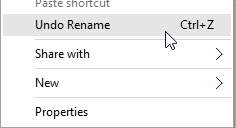
 Right click in a blank area in the window to open the context menu.
Right click in a blank area in the window to open the context menu.
-
 Click to undo the change.
Click to undo the change.
This works well when the highlight has been lost. The label will return to paint docs.
 Which action is the last Undo action?
Which action is the last Undo action?
The action that you can Undo will change depending on what you just did so the menu item will change, too! The menu item is always for the very last thing you did. But once you Undo that last action, there is a new 'last' action from the history list of action. Unhappily, there is no history list that you can see. So catch those mistakes quickly! History button: The History button on the Home tab of File Explorer is NOT the history list for Undo. Instead it brings up a list of old versions of the selected file that were saved with the File History app. By default File History makes copies of new or changed files each hour for Libraries, Desktop, Contacts, and Favorites. Libraries are the Document, Music, Pictures, and Video folders. You can add other folders and drives to one of the libraries. That is a good idea only if you expect to keep the drive attached to the computer all of the time.
History button: The History button on the Home tab of File Explorer is NOT the history list for Undo. Instead it brings up a list of old versions of the selected file that were saved with the File History app. By default File History makes copies of new or changed files each hour for Libraries, Desktop, Contacts, and Favorites. Libraries are the Document, Music, Pictures, and Video folders. You can add other folders and drives to one of the libraries. That is a good idea only if you expect to keep the drive attached to the computer all of the time.
- Close all open File Explorer windows with the method of your
choice:
Methods to close File Explorer:- Click the
 Close button
Close button  on the Title bar.
on the Title bar.
- Click the
Check it out!
![]() Your Class disk should now contain the following folders:
Your Class disk should now contain the following folders:
 class
class
 200 English
200 English
 excel docs
excel docs
 word docs
word docs
 my docs
my docs
 _1014 History
_1014 History 1012 Algebra
1012 Algebra course info
course info paint docs
paint docs term papers
term papers
